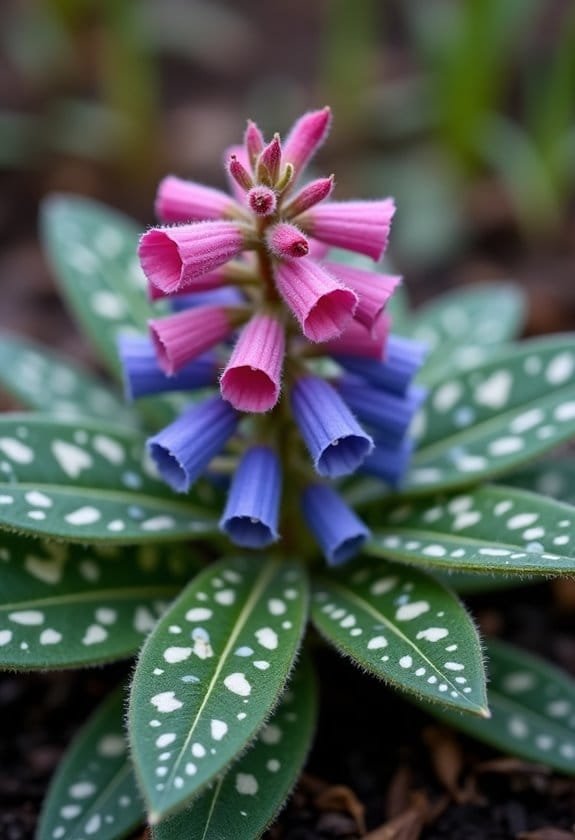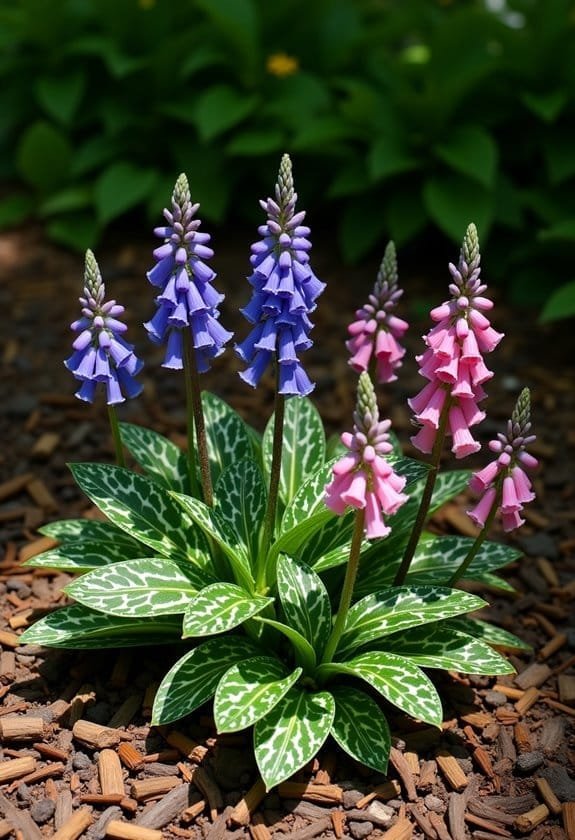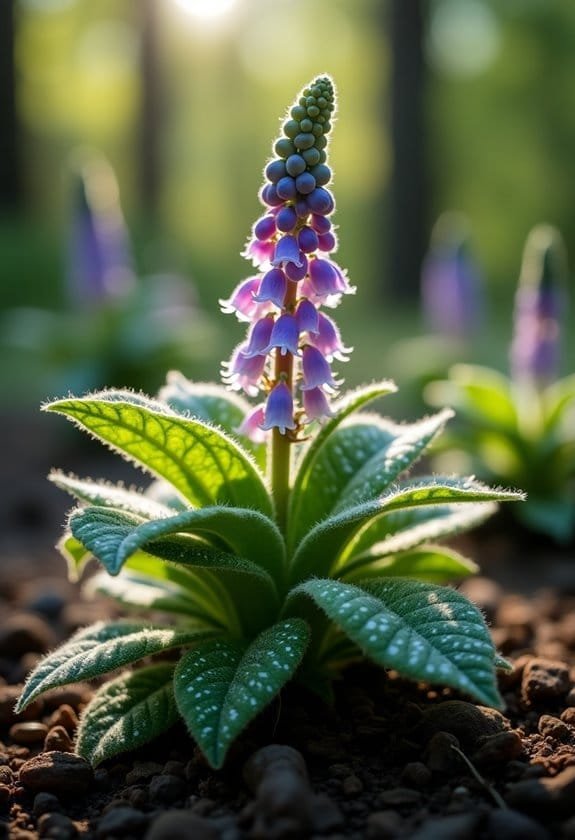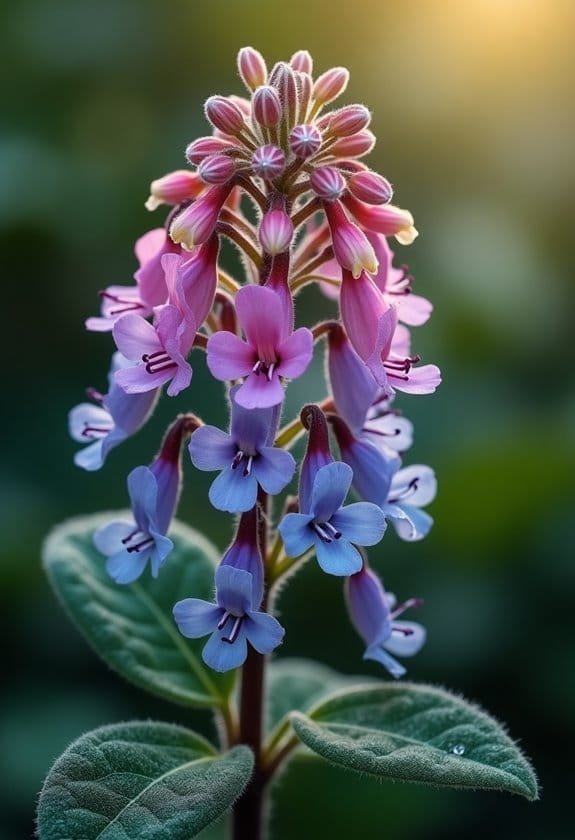Pulmonaria species, known as lungwort, are shade-loving perennial herbs that feature distinctive spotted foliage and remarkable color-changing flowers. These European natives grow 6-12 inches tall and spread up to 2 feet wide, thriving in partial to full shade with consistently moist, well-draining soil. The plant's bell-shaped blooms shift from pink to blue as they mature, attracting early-season pollinators like butterflies and hummingbirds. Lungwort's historical significance stems from medieval medicine, where its spotted leaves were thought to indicate lung-healing properties. Understanding this versatile plant's care requirements reveals its full potential as a striking woodland garden addition.
Main Points
- Pulmonaria (lungwort) is a herbaceous perennial with spotted leaves and early spring flowers that change from pink/violet to blue.
- Native to Europe and Russia, lungworts thrive in partial to full shade and require consistently moist, well-draining soil.
- Plants grow 6-12 inches tall, spread up to 2 feet wide, and feature distinctive white or silver spots on their leaves.
- Early-blooming lungwort flowers provide essential nectar for early-season pollinators, including butterflies and hummingbirds.
- The plant's common name derives from medieval beliefs that its spotted leaves resembled diseased lungs, suggesting medicinal properties.
Introduction

Pulmonaria species, commonly known as lungwort, represent a fascinating genus of herbaceous perennials that earned their name from their distinctively spotted leaves resembling diseased lung tissue.
These resilient plants, comprising approximately 16 species native to Europe and Russia, have established themselves as valuable additions to woodland gardens and shaded landscapes.
The genus's most striking feature lies in its early spring flowers, which undergo a remarkable color transformation from pink or violet to blue, making them particularly significant for early-season pollinators.
Common Name
The common name "lungwort" stems from medieval beliefs in the Doctrine of Signatures, where the plant's spotted leaves were thought to mirror diseased lungs and indicate its use in treating respiratory ailments.
This historical connection between the plant's appearance and its presumed medicinal properties exemplifies how traditional healing practices often relied on visual similarities to identify potential remedies for lung diseases.
The plant carries several alternative names that reflect its cultural and historical significance.
"Blue lungwort" and "common lungwort" emphasize both its characteristic flower coloration and widespread cultivation in gardens.
The fascinating color transformation of its blooms, shifting from pink to blue as they mature, has contributed to regional names like "Jerusalem cowslip" and "Mary's tears."
The suffix "wort," derived from Old English and meaning plant, appears frequently in the nomenclature of medicinal herbs, connecting lungwort to a broader family of traditional healing plants.
This etymology reflects the plant's enduring role in herbal medicine and its cultural significance across different regions and time periods.
Scientific Name
Within botanical nomenclature, *Pulmonaria* derives its scientific name from the Latin word "pulmo," meaning lung – a direct reference to the plant's historical use in treating respiratory conditions.
This genus of flowering plants encompasses approximately 18 distinct species, though garden cultivation typically focuses on only eight of these varieties.
The type species, Pulmonaria officinalis serves as the botanical standard for the genus, characterized by its distinctive spotted foliage that historically reminded herbalists of diseased lung tissue.
As a member of the Boraginaceae family, *Pulmonaria* shares genetic lineage with familiar garden plants like borage and forget-me-nots, reflecting its place within this diverse botanical group.
The taxonomic classification of *Pulmonaria* species presents notable challenges for botanists, particularly when attempting to establish clear boundaries between different species.
This complexity is further compounded by the presence of numerous hybrids, which often display intermediate characteristics between parent species, making definitive identification and classification an ongoing challenge in botanical science.
Overview
Among the most cherished woodland perennials, lungwort stands as a versatile and hardy flowering plant native to Europe and western Asia. This remarkable genus, scientifically known as Pulmonaria, belongs to the Boraginaceae family and comprises between 10 and 18 distinct species that have adapted to thrive in shaded environments.
The plant's distinctive spotted foliage played a significant role in its historical medicinal applications, as early practitioners associated the leaves' mottled appearance with diseased lung tissue. This connection gave rise to both its scientific name, derived from the Latin word "pulmo," and its common name, lungwort.
The genus has evolved to become a valuable garden specimen, particularly appreciated for its early spring blooms that transform from pink to blue as they mature. These color-changing flowers provide essential sustenance for early-season pollinators when few other nectar sources are available.
Pulmonaria's adaptability to shade and its preference for well-drained, organic-rich soil have made it an excellent choice for woodland gardens, where it serves both ornamental and ecological purposes.
Key Features
Pulmonaria species stand out in woodland gardens with their compact growth habit, typically reaching 6 to 12 inches in height while spreading up to 2 feet wide.
The plants' most distinctive feature is their bold-textured foliage, which displays characteristic spots resembling diseased lungs, lending credence to their common name "lungwort."
These shade-loving perennials produce clusters of flowers that undergo a remarkable color transformation in early spring, emerging in pink or violet hues before maturing to a striking blue.
Growth Size
Throughout their growing season, these charming perennials maintain a compact growth habit, typically reaching heights of 6-12 inches while spreading up to 2 feet wide in dense clumps. Their growth size remains consistently manageable, making them ideal candidates for woodland gardens and shaded border plantings where space management is essential.
The plant's distinctive foliage creates a substantial ground-level presence, with large ovate to lance-shaped leaves forming expansive mats that effectively cover their designated growing area. These leaves, adorned with characteristic white or silver spots, persist through late winter, ensuring the plant maintains its spatial impact even during dormancy.
The flowering stems, which emerge unbranched and rough-textured, rise vertically without exceeding 12 inches in height, creating an additional dimensional layer above the leafy base. While the plant's vertical growth remains modest, its horizontal spread can become quite significant over time, as the clumps gradually expand to reach their full two-foot diameter potential.
This spreading nature allows Pulmonaria to function effectively as a ground cover while maintaining a well-proportioned, aesthetically pleasing form throughout the seasons.
Appearance
Distinguished by their striking spotted foliage, lungwort plants showcase a distinctive array of visual features that make them instantly recognizable in garden settings. The spotted leaves, which can grow up to 5 inches in length, display remarkable white or silver markings against their green backdrop, creating an intriguing pattern that historically reminded observers of diseased lung tissue.
The flowers of lungwort present an equally enchanting display, with their bell-shaped blooms undergoing a fascinating color transformation as they mature. Initially emerging in shades of pink or violet, these delicate blossoms gradually shift to a rich blue hue, creating a multicolored effect within each flower cluster.
The plant's foliage exhibits a tactile quality, covered in fine hairs that contribute to its unique texture and sometimes aromatic properties. When established, these herbaceous perennials form dense, attractive rosettes that serve as excellent ground cover.
The combination of their spotted, ovate to lance-shaped leaves and color-changing blooms makes Pulmonaria species particularly striking during their early spring flowering period, when they emerge alongside other seasonal bloomers.
Flowering Season
The arrival of early spring heralds the spectacular flowering season of lungwort, as these garden favorites burst into bloom alongside daffodils and tulips.
During this prime bloom time, Pulmonaria species showcase their remarkable color-changing abilities, with flowers shifting from vibrant pink or violet hues to striking shades of blue.
What makes their flowering pattern particularly fascinating is the sequential development of blooms before the foliage reaches full maturity. This strategic timing allows the plants to maximize their appeal to early-season pollinators, particularly bees and butterflies emerging from winter dormancy.
The bell-shaped blossoms cluster together in magnificent displays, creating focal points throughout the spring garden landscape.
Different cultivars exhibit subtle variations in their flowering schedules, with some varieties extending their display well into the mid-spring period.
The prolonged blooming window of certain species provides gardeners with extended opportunities to enjoy these enchanting plants, while their color transformation adds an element of dynamic interest to spring garden designs.
Growing Requirements

Pulmonaria species flourish best in partial to full shade conditions, making them perfect companions for woodland gardens and shaded landscape areas.
These adaptable plants require consistently moist, well-draining soil enriched with organic matter, though they'll suffer in waterlogged conditions that can lead to root rot.
The ideal growing temperature range spans from cool spring conditions through moderate summer heat, with plants demonstrating remarkable resilience when properly established in their preferred environment.
Light
Successful cultivation of Pulmonaria species depends heavily on providing the right light conditions. These woodland natives thrive in shaded environments, where their light blue flowers and distinctive foliage can flourish in well-drained soil without the stress of direct sunlight.
While they demonstrate some adaptability, their natural preference for shadier locations reflects their evolution as understory plants. For ideal growth, Pulmonaria species should be situated in partial to full shade, particularly beneath tree canopies or along woodland garden paths.
Morning sun can be tolerated, but prolonged exposure to direct sunlight risks scorching their delicate leaves and compromising their overall vigor. The plants' characteristic mottled foliage maintains its striking appearance best when protected from harsh afternoon rays.
In deeply shaded locations, while flower production may decrease, the ornamental value of their spotted leaves remains intact. Gardeners should note that finding the right balance of light is essential, as excessive shade can reduce blooming, while too much sun can stress the plants and necessitate increased watering to maintain adequate moisture levels in the soil.
Soil
Growing in well-drained, organically rich soil provides the foundation for healthy Pulmonaria development. These adaptable perennials thrive when their root systems can access essential nutrients through soil with a pH ranging from 6.0 to 7.0, striking an ideal balance between acidity and neutrality. The plants' robust growth depends on maintaining consistent moisture levels throughout their growing season, though they've developed some resilience to brief dry spells.
For gardeners dealing with heavy clay soils, incorporating organic matter becomes crucial for creating an environment where Pulmonaria can flourish. This amendment process transforms dense soil into a more hospitable medium, allowing roots to establish themselves properly while facilitating proper drainage and aeration.
A layer of organic mulch serves multiple purposes in Pulmonaria cultivation, acting like a protective blanket that locks in crucial soil moisture while simultaneously suppressing competitive weed growth. The mulch gradually decomposes, further enriching the soil structure and contributing to the long-term health of these shade-loving perennials, creating a self-sustaining cycle of soil improvement that benefits the plants year after year.
Water
Maintaining proper water levels stands as one of the most critical factors in cultivating healthy Pulmonaria plants. These woodland perennials require consistent moisture throughout their growing season, especially during extended dry spells when supplemental watering becomes essential for their survival.
While they demonstrate remarkable resilience once established, regular monitoring of soil moisture helps prevent stress-induced decline.
The key to successful Pulmonaria cultivation lies in striking the perfect balance between adequate moisture and proper drainage. Though these plants thrive in consistently damp conditions, waterlogged soil can quickly lead to devastating root rot, compromising the entire plant's health.
A thick layer of organic mulch serves as nature's moisture regulator, helping maintain ideal water retention while simultaneously protecting the root system. Morning sun exposure works in harmony with proper watering practices, as the gentle early light allows the foliage to dry gradually while preserving essential soil moisture.
Gardeners should aim to keep the soil consistently moist but never saturated, adjusting their watering schedule based on seasonal changes and local climate conditions.
Temperature
Pulmonaria species flourish within USDA hardiness zones 3-9, adapting remarkably well to temperate climates with moderate temperature fluctuations. These resilient perennials demonstrate a clear preference for cooler growing conditions, which directly influences their robust development and disease resistance patterns.
For ideal growth, Lungworts require carefully managed temperature conditions, particularly during the warmer months when heat stress can compromise their liveliness. Morning sun exposure proves beneficial, but these plants thrive best when sheltered from intense afternoon heat, making them ideal candidates for woodland gardens and shaded borders.
The surrounding soil temperature plays a significant role in maintaining the moist conditions these plants need, as cooler soil helps retain essential moisture levels throughout their root zone. Gardeners should monitor environmental temperatures closely, as excessive heat can lead to withering foliage and reduced flowering performance.
In regions approaching the warmer end of their hardiness range, additional shade provisions and consistent soil cooling strategies, such as organic mulching, become particularly important for sustaining healthy growth patterns throughout the growing season.
Pollinator Criteria
Pulmonaria's distinctive bell-shaped flowers serve as crucial early-spring nectar stations for long-tongued bees, butterflies, and occasional hummingbirds.
The flowers' remarkable color transformation from pink to blue throughout their blooming period attracts diverse pollinator species, maximizing the plant's reproductive success through cross-pollination.
These specialized tubular blooms contain abundant nectar reserves that sustain essential pollinators during the critical early spring season when alternative food sources remain scarce.
Attracted Pollinators
Throughout early spring when food sources are scarce, lungwort species play a vital role in supporting diverse pollinators. The flowers attract an impressive array of beneficial insects and other creatures, particularly during the significant period when many pollinators first emerge from winter dormancy.
These adaptable plants have evolved a fascinating strategy of color-changing blooms, evolving from pink or violet to blue as they mature. This chromatic transformation serves as a visual signal to various pollinators, with bees showing particular interest in the mature blue flowers.
The plant's large, hairy leaves create an effective defensive barrier against herbivores while maintaining accessibility for nectar-seeking visitors.
Lungwort's significance extends beyond its immediate appeal to pollinators, as it contributes substantially to the broader ecological network. Their reliable early-season blooming pattern synchronizes perfectly with the emergence of various pollinator species, including butterflies and hummingbirds.
This temporal alignment makes Pulmonaria species essential components of garden biodiversity, fostering the development of robust pollinator populations that support entire ecosystems throughout the growing season.
Pollination Method
A sophisticated pollination mechanism defines how lungwort species attract and accommodate their essential pollinators. The plant's strategy revolves around its remarkable color-changing flowers, which shift from pink flowers to blue as they mature, creating a visual signal system for visiting insects.
The bell-shaped blooms are architecturally designed to facilitate efficient pollination, with their structure allowing various pollinators to access the nectar and pollen effectively. During early spring, when many insects emerge from hibernation, these flowers serve as vital feeding stations for early-season pollinators, particularly bees and butterflies seeking sustenance after their winter dormancy.
The plant's color transformation isn't merely aesthetic; it serves as a complex communication system that guides pollinators to flowers at different maturity stages. This chromatic evolution helps guarantee consistent pollinator visits throughout the flowering period, as insects can readily identify which blooms contain the most accessible nutrients.
The timing of lungwort's flowering period strategically coincides with the emergence of hibernating insects, establishing a mutually beneficial relationship that supports both plant reproduction and pollinator survival.
Care & Maintenance

Successful cultivation of Pulmonaria begins with proper placement in well-drained, organic-rich soil where the plants can receive morning sunlight while enjoying afternoon shade.
Maintaining consistent soil moisture through regular watering and applying a balanced fertilizer in spring establishes the foundation for robust growth, while pruning spent blooms encourages fresh foliage development.
These shade-loving perennials benefit from division every 3-5 years and pair beautifully with other woodland plants like ferns, hostas, and spring-flowering bulbs that share similar growing requirements.
Planting Tips
Growing healthy Pulmonaria plants requires attention to basic care principles that guarantee their long-term success. When considering planting tips, gardeners should prioritize selecting a location with dappled shade or partial sun exposure, as these conditions promote ideal foliage development and prevent leaf scorching.
The most vital aspect of lungwort cultivation lies in soil preparation, where well-drained soil enriched with organic matter creates an excellent growing environment. Gardeners should incorporate generous amounts of compost or aged manure into the planting site, ensuring proper moisture retention while preventing waterlogged conditions that can lead to root rot.
For successful establishment, space plants approximately 12-18 inches apart to accommodate their eventual spread, planting at the same depth as they were in their nursery containers.
After planting, apply a 2-inch layer of organic mulch around the base, keeping it slightly away from the crown to prevent moisture-related issues. Regular watering during the first growing season helps develop strong root systems, though careful attention must be paid to avoid oversaturation, as Pulmonaria thrives in consistently moist but not waterlogged conditions.
Ongoing Care
With proper ongoing care, Pulmonaria plants reward gardeners with vibrant foliage and reliable blooms year after year. These woodland perennials thrive when their specific maintenance requirements are consistently met, particularly regarding soil moisture and nutrition.
Regular watering forms the cornerstone of Pulmonaria care, as these plants require consistently moist, well-draining soil to maintain their lush appearance. During dry spells, increased irrigation becomes essential to prevent stress-induced decline.
To support healthy growth, gardeners should apply a balanced, slow-release fertilizer in spring or enrich the soil with a generous layer of nutrient-rich compost.
Pruning plays a crucial role in maintaining Pulmonaria's vitality, with post-flowering trimming encouraging fresh foliar development throughout the growing season.
As the plants mature and expand, division becomes necessary every three to five years, preventing overcrowding and ensuring continued vigor. This process involves carefully separating established clumps into smaller sections, each capable of developing into a robust new plant.
Through these attentive care practices, gardeners can maintain thriving Pulmonaria specimens that enhance their woodland gardens with enduring beauty.
Suggested Companions
Selecting compatible companion plants enhances both the beauty and performance of Pulmonaria in woodland gardens. The mottled leaves of lungwort create striking visual harmony when paired with hostas, whose broad, lush foliage provides an excellent structural counterpoint in shady locations.
Lady Ferns, with their delicate fronds, introduce a feathery texture that complements Pulmonaria's spotted foliage while maintaining the woodland garden aesthetic.
Heuchera varieties offer an array of foliage colors, from deep burgundy to caramel, creating dynamic contrast with lungwort's silver-speckled leaves in dappled shade conditions.
For vertical interest, Astilbe's graceful flower plumes emerge above the low-growing Pulmonaria, adding architectural elements to the garden composition during summer months.
Spring-flowering bulbs, particularly daffodils and tulips, can be strategically integrated among lungwort plantings to provide early-season color and height variation.
These bulbs naturally complete their growth cycle as Pulmonaria reaches peak foliage display, creating a seamless succession of garden interest throughout the growing season.
Common Issues
While Pulmonaria species demonstrate notable resilience against most garden pests, they face several potential challenges that gardeners should monitor.
The most significant threats include powdery mildew in humid conditions, root rot in poorly-drained soils, and occasional slug damage to their distinctive foliage.
Proper spacing for air circulation, regular division every 3-5 years, and maintaining well-drained soil conditions serve as effective preventive measures against these common issues.
Pests/Diseases
Most Pulmonaria species demonstrate strong natural resistance to pests and diseases, though they can face several common challenges. The most prevalent issue is powdery mildew, which manifests as a white, dusty coating on leaves, particularly when plants are situated in overly shaded or humid environments.
While this fungal infection rarely proves fatal, it can considerably diminish the ornamental value of these otherwise striking perennials.
Slugs and snails pose another noteworthy threat to Pulmonaria plants, as these gastropods are particularly drawn to the succulent foliage, leaving behind characteristic irregular holes and ragged leaf edges.
Regular monitoring and appropriate preventive measures can effectively manage these unwanted visitors. To combat both fungal and pest issues, maintaining proper cultural conditions is essential.
Ensuring adequate air circulation around plants serves as a natural defense against powdery mildew, while well-drained soil prevents the development of root rot.
Remarkably, hybrid varieties derived from Pulmonaria longifolia have demonstrated enhanced resistance to powdery mildew, making them excellent choices for gardens where fungal issues have historically been problematic.
Solutions
Successful cultivation of Pulmonaria requires proactive solutions to common growing challenges. When powdery mildew appears as a whitish coating on the leaf surface, improving air circulation and reducing overhead watering can greatly minimize its occurrence.
For plants displaying pink-tinged foliage that's suffering from drought stress, increasing shade protection and maintaining consistent soil moisture will help restore their energy.
To combat persistent slug damage, gardeners can implement organic control methods such as copper barriers or environmentally friendly slug pellets, while regularly inspecting plants during evening hours when these pests are most active.
Root rot prevention demands careful attention to soil drainage, and incorporating organic matter or coarse sand can enhance soil structure in poorly draining areas.
The practice of division every 3-5 years serves multiple purposes: it prevents overcrowding, rejuvenates declining clumps, and helps maintain plant strength by giving each section adequate space to develop.
When dividing, verify each section has healthy roots and several leaves, replanting immediately at the same depth as the original plant.
Summary

The remarkable diversity and history of Pulmonaria species showcase their enduring appeal in both gardens and herbal traditions. These woodland plants, with their distinctive dark green leaves and color-changing blooms, have captivated gardeners and herbalists for centuries, particularly due to their unique spotted foliage that inspired their common name, lungwort.
The genus comprises 10 to 18 species, though gardeners typically cultivate only eight primary varieties, including the widely recognized Pulmonaria officinalis. These adaptable plants have proven themselves invaluable in shade gardens, thriving in moist, organically enriched soils while requiring minimal maintenance.
Their early spring flowers, evolving from pink or violet to blue, provide essential nectar for emerging pollinators. While the plant's historical medicinal applications, based on the Doctrine of Signatures, haven't withstood scientific scrutiny, Pulmonaria's cultural significance remains intact.
Modern gardeners appreciate these versatile plants for their reliable performance, striking foliage patterns, and ability to flourish in challenging shaded conditions, making them enduring favorites in woodland gardens across temperate regions.


